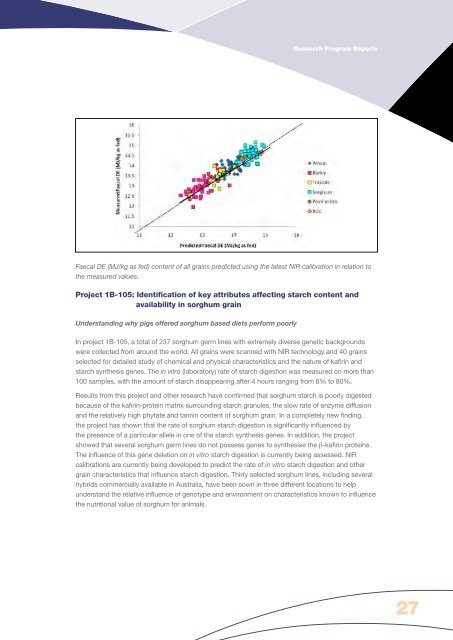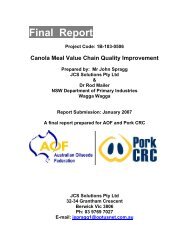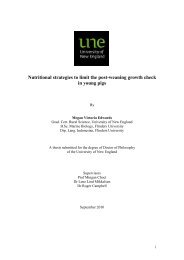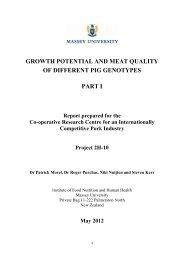annual report 09/10 - Apri.com.au
annual report 09/10 - Apri.com.au
annual report 09/10 - Apri.com.au
Create successful ePaper yourself
Turn your PDF publications into a flip-book with our unique Google optimized e-Paper software.
Research Program ReportsBoth the robustness and precision of the calibrations can be further improved with the addition ofmore grains with widely varying characteristics. Careful selection of grains with varying NIR scanswill continue. An accurate and rapid method for measuring the energy value of grains is essentialfor improving the formulation of rations for pigs of all ages. A difference of 1 MJ/kg has beenestimated to be worth from approximately $5-18 per tonne (if the price of wheat is $250 per tonne)depending on the relative prices of alternative grains, fibre sources and high energy ingredients.Figure XXX - Faecal DE (MJ/kg as fed) content of all grains predicted using the latest NIRcalibration in relation to the measured values.Faecal DE (MJ/kg as fed) content of all grains predicted using the latest NIR calibration in relation toThe solid line represents the linear regression equation (Y = 0.97X + 0.36; R 2 = 0.89) and the dottedthe measured line is values. the line of equivalence.1B-<strong>10</strong>5: Identification of the key attributes affecting starch content and availability in sorghumProject 1B-<strong>10</strong>5: grain Identification of key attributes affecting starch content andUnderstanding why pigs offered sorghum based diets perform poorlyavailability in grainIn project 1B-<strong>10</strong>5, a total of 237 sorghum germ lines with extremely diverse genetic backgroundswere collected from around the world. All grains were scanned with NIR technology and 40 grainsselected for detailed study of chemical and physical characteristics and the nature of kafirin andUnderstanding why pigs offered sorghum based diets perform poorlystarch synthesis genes. The in vitro (laboratory) rate of starch digestion was measured on morethan <strong>10</strong>0 samples, with the amount of starch disappearing after 4 hours ranging from 8% to 80%.In project 1B-<strong>10</strong>5, a total of 237 sorghum germ lines with extremely diverse genetic backgroundswere collected from around the world. All grains were scanned with NIR technology and 40 grainsselected for detailed study of chemical and physical characteristics and the nature of kafirin andstarch synthesis genes. The in vitro (laboratory) rate of starch digestion was measured on more than<strong>10</strong>0 samples, with the amount of starch disappearing after 4 hours ranging from 8% to 80%.Results from this project and other research have confirmed that sorghum starch is poorly digestedbec<strong>au</strong>se of the kafirin-protein matrix surrounding starch granules, the slow rate of enzyme diffusionResults from this project and other research have confirmed that sorghum starch is poorly digestedand the relatively bec<strong>au</strong>se of high the kafirin-protein phytate and matrix tannin surrounding content of starch sorghum granules, grain. the slow In rate a <strong>com</strong>pletely of enzyme diffusion new finding,and the relatively high phytate and tannin content of sorghum grain. In a <strong>com</strong>pletely new finding,the project the has project shown has shown that the that rate the rate of sorghum of sorghum starch digestion is significantly is significantly influenced influenced by the bythe presence presence of a of a particular allele in in one of the starch synthesis synthesis genes. genes. In addition, In addition, the project the showed projectthat several sorghum germ lines do not possess genes to synthesise the β-kafirin proteins. Theshowed that influence several of this sorghum gene deletion germ on lines vitro do starch not possess digestion is genes currently to synthesise being assessed. the NIR β-kafirin proteins.The influence of this gene deletion on in vitro starch digestion is currently being assessed. NIRcalibrations are currently being developed to predict the rate of in vitro starch digestion and othergrain characteristics that influence starch digestion. Thirty selected sorghum lines, including severalhybrids <strong>com</strong>mercially available in Australia, have been sown in three different locations to helpunderstand the relative influence of genotype and environment on characteristics known to influencethe nutritional value of sorghum for animals.27





